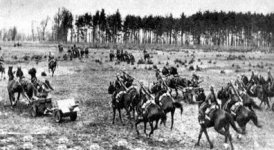I wish they would push it back to 1939 maybe polish lancers would be a nice add.........................
"Perhaps the most vivid image to have emerged from the September Campaign is the picture of a squadron of courageously foolhardy Polish lancers charging a wave of steel Panzers. That such attack never occured does not sem to have diminished the popularity of these tales, even among serious historians. The tales originated in the first days of the campaign from the pens of Italian correspondents on the Pomeranian front. They were embesllished by German propagandists and became more fanciful with each new telling. The orginal source was a small skirmish near the hamlet of Krojanty on the evening of 1 September. The Pomeranian Corridor was defended by several Polish infantry divisions and the Pomeranian Cavalry Brigade. The area was indefensible, but the force was stationed to prevent the Germans from making an unopposed seizure of the contested Corridor, as they had the Sudetenland. Upon the outbreak of war these forces were immediately to withdraw southward. Covering the retreat was Col. Mastalerz with his 18th Lancers and a number of infantry regiments. In the early morning of 1 September, Gen. Heinz Guderian's 2nd and 20th Motorised Division began their drive on Polish forces in the Tuchola forest. The cavalry and infantry were able to hold them back until the early afternoon, when the Germans began to push the Poles back. By late afternoon a key rail and road junction through the forest was threatened and Mastalerz was ordered to repulse the German thrust at all costs. Mastalerz had his own regiment, some infantry and the Brigade's tankettes at his disposal. The TK tankettes were old and worn out, and were left with a portion of the regiment to hold the existing positions. Two Lancer squadrons mounted up and began to swing around the German flank to strike them in the rear.
By early evening they had located a German infantry battalion exposed in a clearing. The squadrons were already within a few hundred yards, and a sabre charge seemed the sensible course. In moments the two squadrons had swept out of the woods and wiped out the unprepared with hardly any casaulties. As the troops were re-forming, a few German armoured cars equipped with automatic 20mm cannon and machine guns happened on the scene and immediately began firing. The Poles were completely exposed, and began to gallop for cover behind a nearby hillock. Mastalerz and his immediate staff were all killed, and the losses were terrible. The grim evidence of this encounter was discovered the following day by Italian war correspondents, who were told by German soldiers that it resulted from the cavalry having charged tanks and so the legend began. What has escaped attention was the fact that later that evening Guderian had to step in to prevent the 2nd Motorised Division from retreating 'in the face of intense cavalry pressure'. This intense pressure came from a decimated regiment which had lost 60 per cent of its strenght in the day's fighting and was not even a tenth of the size of the German unit it was pushing back."
German propaganda used this event to create 'stupid Polish cavalry' myth which was believed by Germans (some soldiers even wrote in their memories that Poles used their sabres and lances agains tanks and explained that they thought the tanks were made of paper) and Poles. Propaganda films even showed "authentic" charges on tanks. It is presented even in post-war Polish "Lotna" film, created by famous in Poland Wajda director. This film made Polish veterams very angry.
Why did Germans create the "stupid Polish cavalry" myth ? The propable explaination is they wanted to convince Western nations Poland was not a valuable ally. Such myths were made to prevent USA to make a serious protests and maybe prevent other nations to join the war.
If interest in this period the polish movie LOTNA would be a good one....


